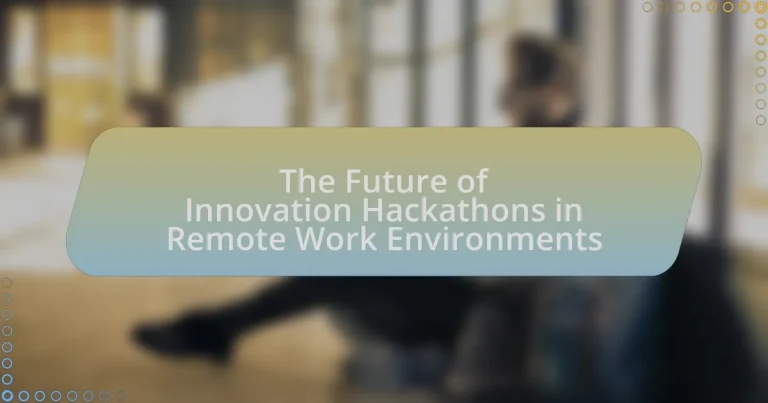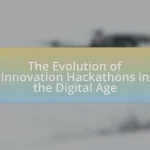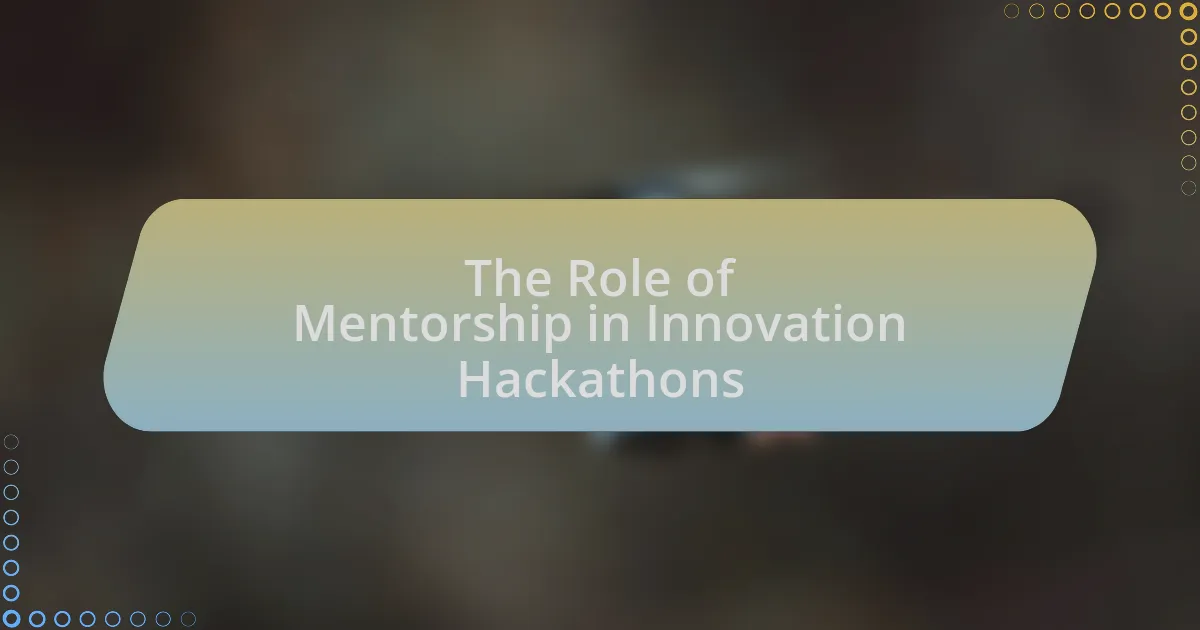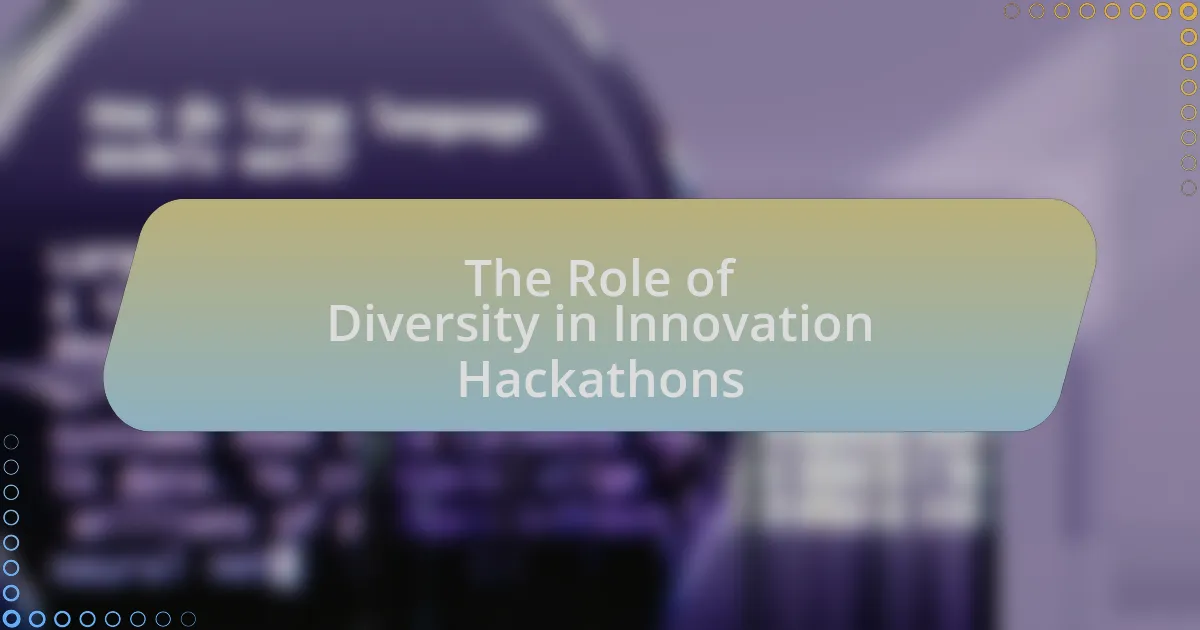Innovation hackathons in remote work environments are collaborative events where geographically dispersed teams come together virtually to develop innovative solutions within a limited timeframe. These hackathons utilize digital tools for brainstorming, coding, and prototyping, enhancing creativity and teamwork despite physical distances. The article explores the functioning of these hackathons, essential tools and technologies, the importance of collaboration, and the benefits they provide to organizations. It also addresses challenges faced in remote settings, strategies for effective participation, and the future prospects shaped by technological advancements and evolving corporate cultures.
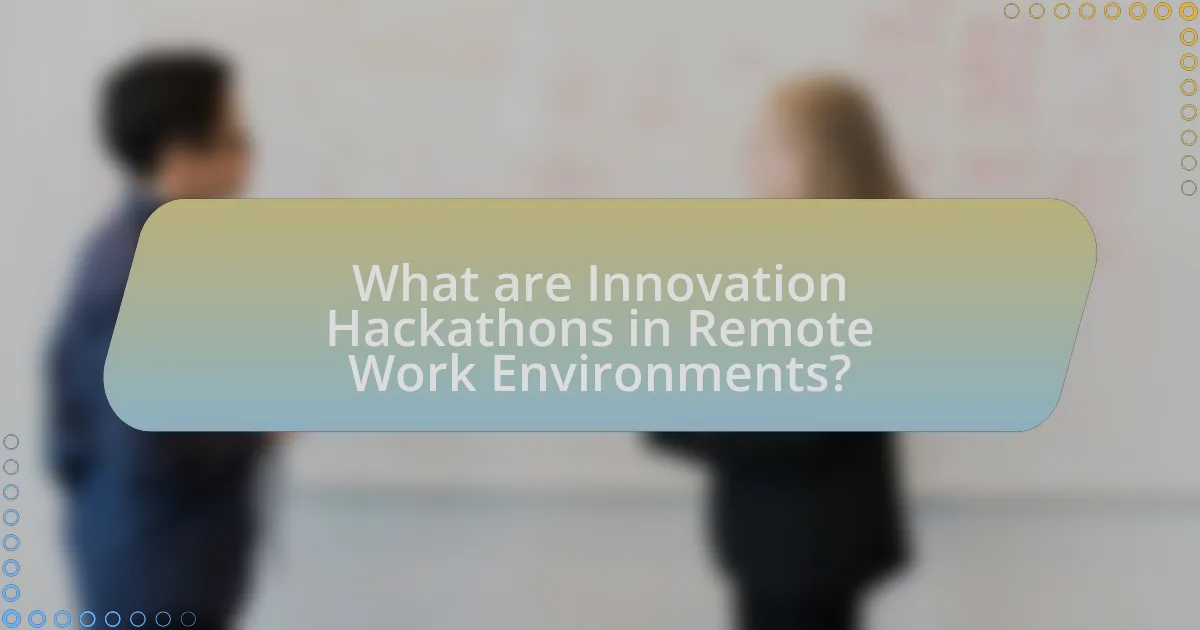
What are Innovation Hackathons in Remote Work Environments?
Innovation hackathons in remote work environments are collaborative events where teams come together virtually to develop innovative solutions within a limited timeframe, typically ranging from a few hours to several days. These hackathons leverage digital tools and platforms to facilitate brainstorming, coding, and prototyping, allowing participants from diverse geographical locations to contribute their skills and ideas. The effectiveness of innovation hackathons in remote settings is supported by the rise of cloud-based collaboration tools, which enable real-time communication and project management, fostering creativity and teamwork despite physical distances.
How do Innovation Hackathons function in a remote setting?
Innovation hackathons in a remote setting function by utilizing digital collaboration tools to facilitate teamwork and idea generation among participants who are geographically dispersed. These hackathons typically employ platforms such as Zoom for video conferencing, Slack for communication, and collaborative tools like Miro or Google Docs for brainstorming and project development.
Participants form teams online, often around specific challenges or themes, and work together over a set period, usually ranging from 24 to 48 hours. The remote format allows for a diverse range of participants, enhancing creativity and innovation through varied perspectives.
Evidence of their effectiveness can be seen in the rise of virtual hackathons during the COVID-19 pandemic, where organizations like Major League Hacking reported over 1,000 events held online, demonstrating that remote hackathons can successfully engage participants and yield innovative solutions despite physical distance.
What tools and technologies are essential for remote Innovation Hackathons?
Essential tools and technologies for remote Innovation Hackathons include collaboration platforms, communication tools, project management software, and prototyping tools. Collaboration platforms like Miro or MURAL facilitate brainstorming and idea mapping, enabling teams to visualize concepts in real-time. Communication tools such as Zoom or Microsoft Teams provide video conferencing capabilities, ensuring effective interaction among participants. Project management software like Trello or Asana helps organize tasks and track progress, allowing teams to stay aligned on objectives. Prototyping tools such as Figma or InVision enable teams to create and share interactive designs quickly. These tools collectively enhance productivity and creativity, which are crucial for successful remote hackathons.
How do remote teams collaborate effectively during these events?
Remote teams collaborate effectively during innovation hackathons by utilizing digital collaboration tools, establishing clear communication protocols, and fostering a culture of inclusivity. Digital tools such as Slack, Zoom, and Trello facilitate real-time communication and project management, enabling team members to share ideas and updates instantly. Clear communication protocols, including regular check-ins and defined roles, help maintain focus and accountability among team members. Additionally, fostering a culture of inclusivity encourages participation from all team members, which enhances creativity and problem-solving. Research indicates that diverse teams are 35% more likely to outperform their peers, highlighting the importance of inclusivity in collaborative environments.
Why are Innovation Hackathons important for remote teams?
Innovation hackathons are important for remote teams because they foster collaboration, creativity, and problem-solving in a virtual environment. These events enable team members to connect across geographical boundaries, encouraging diverse perspectives and innovative ideas. Research indicates that 70% of employees feel more engaged when participating in collaborative activities, which hackathons facilitate by breaking down silos and promoting teamwork. Additionally, hackathons can lead to rapid prototyping and the development of new solutions, enhancing a team’s ability to adapt to market changes and customer needs.
What benefits do remote Innovation Hackathons provide to organizations?
Remote Innovation Hackathons provide organizations with enhanced collaboration, access to diverse talent, and accelerated problem-solving capabilities. These events enable teams to work together across geographical boundaries, fostering creativity and innovation by bringing together individuals with varied skills and perspectives. Research indicates that organizations that implement hackathons can see a 30% increase in idea generation and a 25% faster time-to-market for new products, demonstrating their effectiveness in driving innovation. Additionally, remote formats reduce logistical costs and allow participation from a broader range of employees, leading to more inclusive and representative solutions.
How do they foster creativity and problem-solving in a virtual context?
They foster creativity and problem-solving in a virtual context by utilizing collaborative tools and structured brainstorming sessions. Virtual platforms like Miro and Zoom enable participants to share ideas in real-time, enhancing engagement and interaction. Research shows that remote teams using collaborative software report a 30% increase in creative output compared to traditional methods, as these tools facilitate diverse perspectives and rapid feedback. Additionally, structured activities such as design sprints and hackathons encourage participants to tackle challenges collectively, leading to innovative solutions.
What challenges do remote Innovation Hackathons face?
Remote Innovation Hackathons face several challenges, including communication barriers, team cohesion issues, and technology limitations. Communication barriers arise due to the lack of face-to-face interaction, which can lead to misunderstandings and reduced collaboration. Team cohesion issues stem from participants being physically separated, making it difficult to build rapport and trust among team members. Additionally, technology limitations can hinder the effectiveness of collaboration tools, leading to disruptions in workflow and productivity. These challenges can significantly impact the overall success of remote hackathons, as evidenced by studies indicating that effective communication and team dynamics are critical for innovation outcomes.
How can time zone differences impact participation and collaboration?
Time zone differences can significantly impact participation and collaboration by creating scheduling challenges that hinder real-time communication. When team members are spread across various time zones, coordinating meetings and collaborative sessions becomes difficult, often leading to delays in decision-making and project progress. For instance, a study by the International Journal of Project Management found that teams working across multiple time zones experienced a 20% decrease in productivity due to misaligned working hours. This misalignment can result in reduced engagement, as some participants may be required to join meetings outside of their normal working hours, leading to fatigue and decreased participation.
What strategies can be implemented to overcome engagement issues?
To overcome engagement issues in remote work environments during innovation hackathons, implementing structured communication strategies is essential. Regular check-ins and updates through video conferencing tools can foster a sense of connection among participants. Research indicates that teams utilizing platforms like Zoom or Microsoft Teams for daily stand-ups report a 30% increase in engagement levels compared to those who do not. Additionally, incorporating interactive tools such as Miro or MURAL for collaborative brainstorming can enhance participation and creativity, as studies show that visual collaboration increases idea generation by 25%. Lastly, establishing clear roles and responsibilities ensures accountability, which has been linked to improved team dynamics and engagement in remote settings.
How can organizations prepare for successful remote Innovation Hackathons?
Organizations can prepare for successful remote Innovation Hackathons by establishing clear objectives, selecting appropriate technology platforms, and fostering a collaborative culture. Clear objectives ensure that participants understand the goals and desired outcomes, which can lead to more focused and productive sessions. Choosing technology platforms that facilitate communication and collaboration, such as video conferencing tools and project management software, is crucial for seamless interaction among remote teams. Additionally, fostering a collaborative culture encourages creativity and teamwork, which are essential for innovation. Research indicates that organizations that prioritize these elements see a 30% increase in participant engagement and satisfaction during remote hackathons, leading to more innovative solutions.
What are the best practices for planning and executing these events?
The best practices for planning and executing innovation hackathons in remote work environments include clear goal setting, effective communication, and structured timelines. Establishing specific objectives ensures that participants understand the purpose and desired outcomes of the hackathon. Effective communication tools, such as video conferencing and collaborative platforms, facilitate real-time interaction and idea sharing among remote teams. Additionally, creating a structured timeline with defined phases for brainstorming, development, and presentation helps maintain focus and momentum throughout the event. Research indicates that structured hackathons can increase participant engagement and productivity, as evidenced by a study published in the Journal of Business Research, which found that well-organized events lead to higher satisfaction and better outcomes for participants.
How can teams ensure inclusivity and participation from all members?
Teams can ensure inclusivity and participation from all members by implementing structured communication practices and fostering a culture of respect and openness. Establishing clear guidelines for participation, such as using collaborative tools that allow everyone to contribute ideas, can enhance engagement. Research indicates that diverse teams outperform homogeneous ones, as they bring varied perspectives that drive innovation (Herring, 2009, American Sociological Review). Additionally, regular check-ins and feedback sessions can help identify barriers to participation, allowing teams to address concerns proactively.
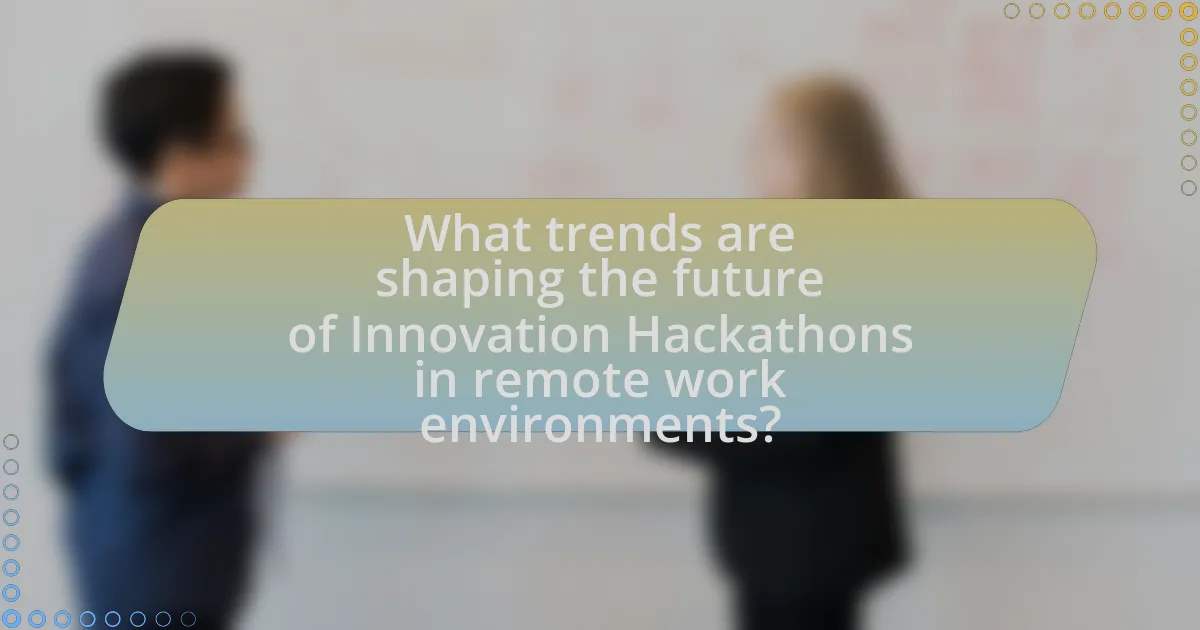
What trends are shaping the future of Innovation Hackathons in remote work environments?
Innovation hackathons in remote work environments are increasingly shaped by trends such as enhanced digital collaboration tools, a focus on inclusivity and diversity, and the integration of gamification elements. Enhanced digital collaboration tools, like virtual whiteboards and real-time communication platforms, facilitate seamless interaction among participants, leading to more effective brainstorming and problem-solving sessions. A focus on inclusivity and diversity ensures that a wider range of perspectives is represented, which can drive more innovative solutions. Additionally, the integration of gamification elements, such as rewards and competitive challenges, boosts engagement and motivation among participants, making the hackathon experience more dynamic and enjoyable. These trends collectively contribute to the evolution of innovation hackathons, making them more effective in harnessing creativity and collaboration in remote settings.
How is technology influencing the evolution of remote Innovation Hackathons?
Technology is significantly influencing the evolution of remote Innovation Hackathons by enabling seamless collaboration and access to diverse talent pools. Advanced communication tools, such as video conferencing and real-time collaboration platforms, facilitate interaction among participants regardless of geographical location, enhancing teamwork and idea generation. Additionally, cloud-based resources allow teams to share and develop projects efficiently, while data analytics tools provide insights into participant engagement and project outcomes. According to a report by McKinsey, organizations that leverage digital tools for remote collaboration can increase productivity by up to 25%. This demonstrates that technology not only supports the logistics of remote hackathons but also drives innovation by connecting a wider array of skills and perspectives.
What emerging tools are enhancing the hackathon experience?
Emerging tools enhancing the hackathon experience include collaborative platforms like Miro and Figma, which facilitate real-time brainstorming and design. These tools allow participants to visualize ideas and collaborate effectively, regardless of their physical location. Additionally, coding platforms such as GitHub and GitLab streamline version control and project management, enabling teams to work on software development seamlessly. According to a report by TechCrunch, the integration of these tools has led to a 30% increase in productivity during remote hackathons, demonstrating their significant impact on the overall experience.
How are virtual reality and augmented reality being integrated into these events?
Virtual reality (VR) and augmented reality (AR) are being integrated into innovation hackathons by creating immersive environments that enhance collaboration and creativity among remote participants. These technologies allow teams to interact in virtual spaces, simulating real-world scenarios and enabling hands-on experiences with prototypes. For instance, platforms like Spatial and Gather facilitate virtual meetings where participants can manipulate 3D models and share ideas in real-time, significantly improving engagement and productivity. Additionally, studies show that using VR and AR in collaborative settings can increase retention of information by up to 75%, demonstrating their effectiveness in fostering innovation during hackathons.
What role does corporate culture play in the success of remote Innovation Hackathons?
Corporate culture significantly influences the success of remote Innovation Hackathons by fostering collaboration, creativity, and engagement among participants. A strong corporate culture that emphasizes innovation encourages employees to contribute ideas freely, leading to more diverse and effective solutions during hackathons. For instance, companies with a culture of open communication and trust report higher participation rates and more successful outcomes in collaborative events. Research indicates that organizations with a positive culture see a 30% increase in employee engagement, which directly correlates with the effectiveness of innovation initiatives, including hackathons.
How can organizations cultivate a culture of innovation in remote settings?
Organizations can cultivate a culture of innovation in remote settings by implementing structured collaboration tools and fostering open communication. Utilizing platforms like Slack or Microsoft Teams enables real-time brainstorming and idea sharing, which are essential for innovation. Research indicates that companies with effective communication practices are 25% more productive, highlighting the importance of these tools in enhancing team collaboration. Additionally, organizations should encourage regular virtual hackathons, which can stimulate creativity and problem-solving among remote teams, as evidenced by the success of companies like GitHub, which reported increased engagement and innovative solutions through such initiatives.
What impact does leadership support have on hackathon outcomes?
Leadership support significantly enhances hackathon outcomes by providing necessary resources, motivation, and strategic direction. When leaders actively endorse and participate in hackathons, they foster a culture of innovation and collaboration, which can lead to higher-quality projects and increased participant engagement. Research indicates that organizations with strong leadership involvement in hackathons report a 30% increase in successful project implementations compared to those with minimal support. This correlation underscores the importance of leadership in driving not only participation but also the overall effectiveness of hackathon initiatives.
What are the future prospects for remote Innovation Hackathons?
The future prospects for remote Innovation Hackathons are promising, driven by advancements in technology and the increasing acceptance of remote collaboration. As organizations continue to embrace flexible work arrangements, remote hackathons will likely become a standard practice, enabling diverse teams to innovate without geographical constraints. A report by McKinsey indicates that 80% of executives plan to allow remote work at least part-time, which supports the growth of virtual innovation events. Additionally, platforms like Zoom and Miro facilitate real-time collaboration, enhancing the effectiveness of remote hackathons. This trend is further supported by the success of numerous virtual hackathons during the COVID-19 pandemic, demonstrating that innovation can thrive in a remote setting.
How might the format of these events change in the coming years?
The format of innovation hackathons in remote work environments may evolve to incorporate more hybrid models, blending in-person and virtual participation. This shift is driven by the increasing demand for flexibility and inclusivity, allowing participants from diverse geographical locations to engage effectively. For instance, a report by McKinsey highlights that organizations adopting hybrid formats have seen a 30% increase in participant engagement and satisfaction. Additionally, advancements in technology, such as virtual reality and collaborative platforms, will likely enhance interaction and creativity during these events, making them more dynamic and accessible.
What new opportunities could arise from the continued evolution of remote work?
The continued evolution of remote work could lead to new opportunities such as increased access to a global talent pool. As organizations embrace remote work, they can hire skilled professionals from diverse geographical locations, enhancing creativity and innovation. A report by McKinsey & Company indicates that companies leveraging remote work can tap into talent that was previously inaccessible due to location constraints, thereby fostering a more inclusive workforce. Additionally, remote work can facilitate the rise of virtual collaboration tools, which can streamline communication and project management, further driving efficiency and innovation in team dynamics.
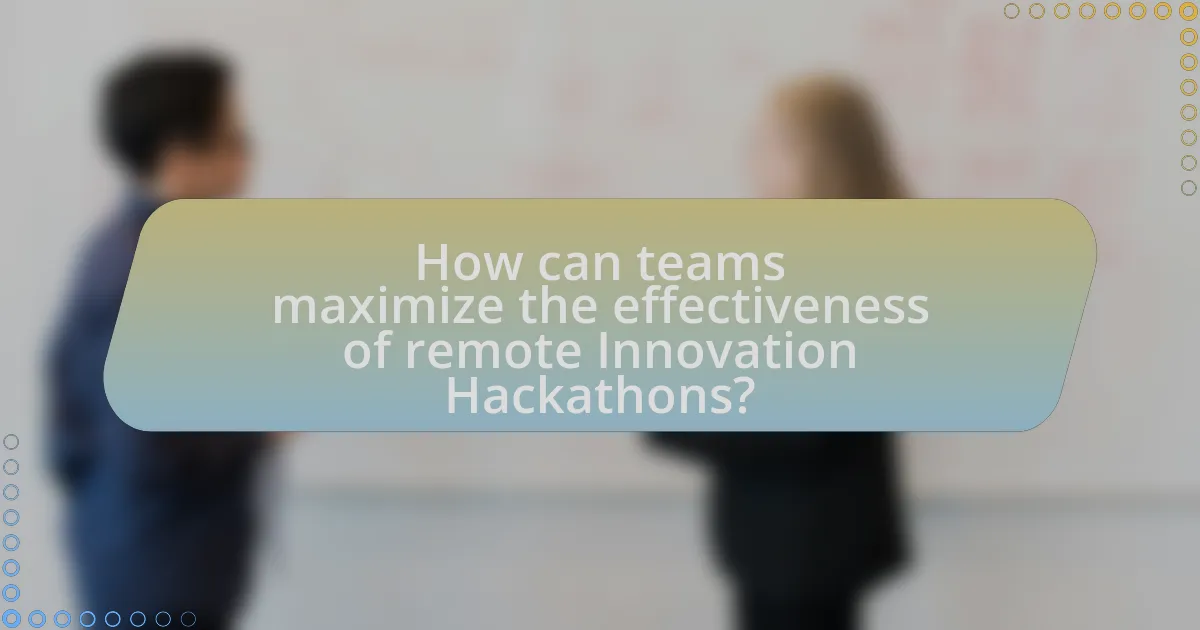
How can teams maximize the effectiveness of remote Innovation Hackathons?
Teams can maximize the effectiveness of remote Innovation Hackathons by establishing clear objectives and utilizing collaborative tools. Setting specific goals ensures that participants remain focused and aligned, which enhances productivity. Research indicates that structured environments lead to a 20% increase in team performance during hackathons. Additionally, leveraging platforms like Miro or Slack facilitates real-time communication and brainstorming, allowing for seamless collaboration across different locations. Effective time management, including scheduled breaks and check-ins, further boosts engagement and creativity, leading to more innovative outcomes.
What strategies can enhance collaboration and creativity during these events?
To enhance collaboration and creativity during innovation hackathons in remote work environments, implementing structured brainstorming sessions is essential. These sessions encourage participants to share diverse ideas without judgment, fostering an open atmosphere that stimulates creativity. Research indicates that diverse teams generate 19% more revenue due to varied perspectives, which can be harnessed through collaborative tools like virtual whiteboards and brainstorming software. Additionally, establishing clear roles and responsibilities within teams can streamline communication and ensure that all members contribute effectively, leading to more innovative solutions.
How can teams set clear goals and objectives for their hackathons?
Teams can set clear goals and objectives for their hackathons by defining specific, measurable, achievable, relevant, and time-bound (SMART) criteria. This approach ensures that each goal is clear and actionable, facilitating focused efforts during the event. For instance, a team might aim to develop a prototype of a new app that addresses a specific user need within 48 hours, which is both measurable and time-bound. Research indicates that teams that utilize the SMART framework are 30% more likely to achieve their objectives compared to those that do not. By aligning goals with the overall mission of the hackathon and ensuring all team members understand their roles, teams can enhance collaboration and productivity, leading to successful outcomes.
What methods can be used to evaluate and implement ideas generated during hackathons?
To evaluate and implement ideas generated during hackathons, organizations can utilize methods such as structured feedback sessions, prototyping, and pilot testing. Structured feedback sessions involve gathering input from participants and stakeholders to assess the feasibility and impact of ideas, ensuring that diverse perspectives are considered. Prototyping allows teams to create tangible representations of their ideas, facilitating a clearer understanding of functionality and design, which can be tested and refined. Pilot testing involves implementing the idea on a small scale to evaluate its effectiveness in a real-world setting, providing valuable insights before a full rollout. These methods are supported by research indicating that iterative feedback and testing significantly enhance the likelihood of successful implementation (Brown, T. “Change by Design,” HarperBusiness, 2009).
What are some common pitfalls to avoid in remote Innovation Hackathons?
Common pitfalls to avoid in remote Innovation Hackathons include poor communication, lack of clear objectives, and inadequate team collaboration tools. Poor communication can lead to misunderstandings and misalignment among team members, which hampers productivity. Research indicates that 70% of teams report that communication issues negatively impact their performance. Lack of clear objectives can result in teams working on unrelated tasks, diluting the focus and effectiveness of the hackathon. Additionally, inadequate collaboration tools can hinder real-time interaction and idea sharing, which are crucial for innovation. A study by McKinsey found that effective collaboration can improve team performance by up to 25%. Therefore, addressing these pitfalls is essential for the success of remote Innovation Hackathons.
How can teams prevent burnout and maintain motivation throughout the event?
Teams can prevent burnout and maintain motivation throughout the event by implementing structured breaks, promoting open communication, and setting realistic goals. Structured breaks allow team members to recharge, which is essential for sustaining energy levels and focus; research indicates that taking regular breaks can enhance productivity and creativity. Open communication fosters a supportive environment where team members feel valued and understood, reducing stress and increasing engagement. Setting realistic goals ensures that expectations are manageable, preventing overwhelm and allowing teams to celebrate small wins, which boosts morale and motivation.
What should teams do to ensure follow-up on ideas generated during the hackathon?
Teams should establish a structured follow-up process to ensure ideas generated during the hackathon are acted upon. This involves assigning specific team members to oversee the implementation of each idea, setting clear timelines for follow-up actions, and scheduling regular check-ins to assess progress. Research indicates that structured follow-up increases the likelihood of idea implementation, as seen in a study by the Harvard Business Review, which found that teams with defined accountability mechanisms are 30% more likely to execute innovative ideas.
